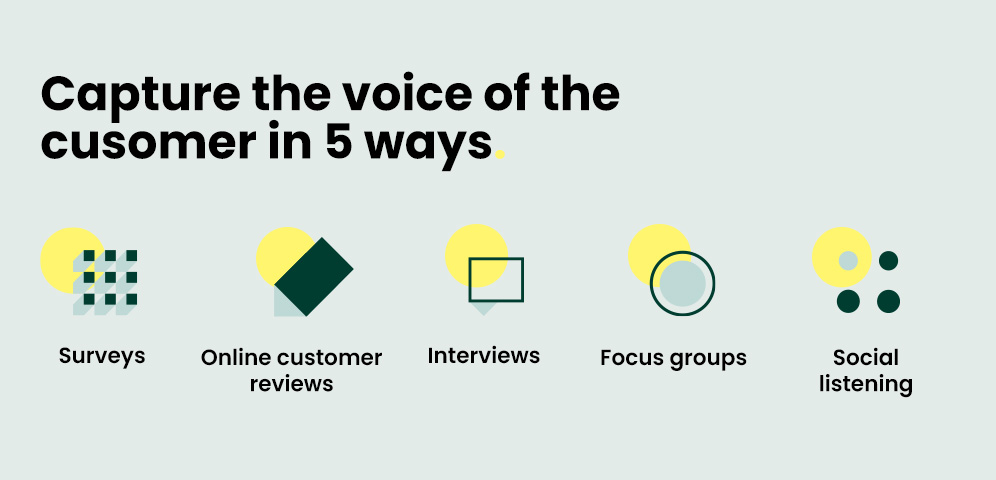
5 ways to capture the voice of the customer (VoC) for category-leading positioning
The most valuable sources of VoC data for B2B marketers.
Brands must position and reposition themselves to evolve with changing customer preferences and stay ahead of market trends – but without validated audience insights, their strategies risk falling flat.
This is why voice of the customer data (VoC) is so important. When you learn about the opinions, desires, demands and motivations of the people who already use your product, you’re in a better position to foster brand loyalty, develop customer-centric products, and drive more sales.
But what sources should you use to capture this type of data, and how do you maximize their usefulness?
In this article, we answer your questions.
What is ‘voice of the customer’ (VoC)?
Voice of the customer is a broad term used to describe the process of capturing data generated by existing customers. It’s a research strategy that gives you insight into what your customers’ preferences and aversions are, which you use to inform your business activities.
Capturing the voice of the customer is more than just monitoring what people say to you about your brand. Companies with a strong customer orientation lean in and take proactive steps to continually gather data from a diverse range of sources—both solicited and unsolicited.
Why is VoC data important for B2B companies?
Traditionally, VoC programmes have long been recognised as a B2C affair because of the wealth of consumer data that B2C firms typically have access to.
However, B2B companies shouldn’t neglect what customers say about their brand, either. According to a Gartner study, an impressive 40–70% of buyers emotionally connect with B2B brands. Understanding what resonates with your audience enables you to uncover hidden opportunities for brand differentiation, establish trust and credibility, and maintain a competitive edge by staying ahead of market trends.
Besides brand positioning, VoC can offer valuable insights into other aspects of your product marketing strategy.
It’s crucial for product development and positioning since customers play a key role in shaping what companies offer. This is especially true for B2B firms where decision-making involves many stakeholders. By listening to customers, businesses can ensure their products meet their needs and stay ahead in industries like tech and SaaS.
VoC data can also improve the effectiveness of your content marketing and market activation efforts. Every day, customers are bombarded with up to 10,000 marketing messages, so messages that mirror how they think and talk are much more likely to convert.
And since 52% of B2B buyers say they’re definitely more likely to purchase from a brand once they’ve read their content, incorporating customer language into your content assets becomes even more important.
It’s worth remembering that the act of gathering VoC data itself is a way of delivering value to customers. For some B2B companies, feedback only ends up with the salespeople (or worse, no one at all). So when you make it clear that customers’ opinions have a direct pathway to all departments across your entire organization, you can differentiate your brand even further, which will help you reduce customer churn and improve satisfaction.

5 ways to capture the voice of the customer
Surveys
The vast majority of companies use surveys to gauge how well they’re performing in the eyes of their customers. As a research method, it’s a fast, inexpensive, and scalable way to capture VoC. But what you actually gain from them is only as good as your approach.
It can be tempting to include a plethora of questions in your surveys using various tools and pre-built templates, but exercise caution. Questions that lack relevance or clarity may prompt customers to provide answers that don’t accurately reflect their opinions and experiences. This phenomenon, known as pseudo-attitude, is a significant concern in marketing research and should be avoided to maintain the integrity of your VoC data.
In addition to excluding irrelevant questions, try not to overwhelm customers with too many questions. Lengthy surveys can lead respondents to engage in satisficing (giving the most minimal answers possible).
To prevent these issues, keep your survey focused on gathering insights into your customers’ desires and expectations. By doing so, you’ll collect high-quality VoC data that can inform actionable positioning strategies.
Online customer reviews
Like surveys, customer reviews are a cheap and effective way to capture the voice of your customers. For B2B software companies, they may be found on sites like G2, Capterra and TrustRadius.
There are two distinct advantages to leveraging reviews as a source of VoC.
First, reviews offer unsolicited feedback from customers, providing marketers with candid, high-quality data that may be challenging to obtain through other channels. This unfiltered input reveals customers’ genuine sentiments and insights, such as their appreciation or dissatisfaction with certain aspects of your brand or product.
Second, reviews typically take an open-ended format, reducing the likelihood of bias. You can anticipate receiving a spectrum of opinions, encompassing both positive and negative feedback. To fully harness the potential of VoC, it’s essential to consider and analyze all reviews, regardless of their tone, to gain comprehensive insights.
Interviews
A more traditional source of capturing VoC data is customer interviews. These interviews can be conducted through various channels, including in-person meetings, phone calls, or video conferencing. If you already have a pool of customers using your product or service, you can engage them in detailed discussions about their purchasing decisions and suggestions for company improvement.
Unlike other data sources, one-on-one interviews offer marketers insights not only into what customers say but also into how they express themselves through their tone of voice and body language.
Given the personalized nature of interviews, it’s crucial to view them as an opportunity to strengthen individual customer relationships. These interactions foster deeper connections and trust, enabling marketers to glean valuable insights while nurturing loyalty and engagement with customers.
Focus groups
To marketers, focus groups have one clear benefit: synergy.
Focus groups offer a unique opportunity for gathering VoC data, especially when multiple customers convene in a physical or virtual setting. In such environments, you can collect a wider range of feedback, which can be very valuable.
What’s more, any remark made by one participant can trigger a chain reaction, sparking dynamic discussions that help highlight the importance of specific topics and themes to your brand.
However, leveraging focus groups effectively requires attention to two critical factors.
First, selecting a skilled moderator is essential. The moderator should possess deep industry knowledge and possess exceptional flexibility and sensitivity to group dynamics. Without these qualities, the session risks becoming unproductive.
Second, careful consideration must be given to the sampling strategy. Focus group participants should exhibit a degree of homogeneity, sharing common characteristics such as occupation or job title. This ensures a comfortable environment where participants feel encouraged to share their perspectives openly.
Social listening
Capturing what customers say to your brand is valuable, but what’s just as necessary is capturing what they say to each other. Social media is a more informal source of collecting VoC data compared to other methods, but the information you get can be extremely useful.
B2B marketers have the opportunity to track discussions surrounding their products or services across various platforms, including Twitter, LinkedIn, and lesser-known platforms like Quora and Reddit, using social media listening tools. Reddit alone hosts over 100,000 online communities, offering a treasure trove of insights into highly niche topics that may be pertinent to your business.
When leveraging social media as a source of VoC, it’s essential to adopt a non-intrusive approach. While customers may not actively seek brand interactions in certain online spaces, they do appreciate brands that listen to their feedback attentively. Therefore, it’s crucial to prioritize listening and understanding rather than overtly engaging in conversations where brands may not be welcome.
What next?
VoC data is an invaluable source of information for any B2B marketer looking to refresh or transform their brand or product positioning. Capturing it not only informs your decisions—it also facilitates an ongoing two-way conversation with your customers. It may not be the only data type you should consider when developing a new brand positioning strategy, but it’s an ideal place to start.
This post has been updated on June 3rd, 2024. Originally published: November 25th, 2021
Read the latest positioning trends and insights.
Tap into our brand and product positioning, storytelling, and creative expertise to inspire your next strategic move.


